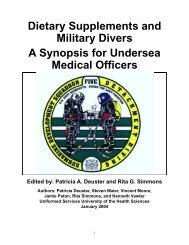Force Health Protection: Nutrition and Exercise Resource Manual
Force Health Protection: Nutrition and Exercise Resource Manual
Force Health Protection: Nutrition and Exercise Resource Manual
Create successful ePaper yourself
Turn your PDF publications into a flip-book with our unique Google optimized e-Paper software.
The loss of muscle mass as you age is directly responsible<br />
for the decline in BMR. Muscle is metabolically active,<br />
which means that it requires a set number of kcals each day<br />
to maintain its mass. On average, people lose some muscle<br />
mass each year after the age of 35 years. This results in<br />
fewer metabolic dem<strong>and</strong>s <strong>and</strong> less total daily kcal<br />
requirements. However, the amount of muscle mass that you<br />
lose is dependent upon how much physical activity you<br />
perform as you age, particularly activities that require<br />
muscle strength such as strength training. By engaging in<br />
strength training exercises you will preserve <strong>and</strong> possibly<br />
gain muscle mass, leading to a 10% to 15% boost in your BMR!<br />
Along with a decrease in muscle mass, inactivity can also lead to an<br />
increase in body fat. This occurs if the number of kcals consumed is greater<br />
than the number of kcals expended through physical activity, as explained<br />
in the energy balance equations in Chapter 1. This simultaneous increase in<br />
body fat <strong>and</strong> decrease in muscle mass leads to a greater body mass index<br />
(BMI) <strong>and</strong> is associated with an increased risk for heart <strong>and</strong> blood vessel<br />
diseases, obesity, diabetes, <strong>and</strong> other diseases (see Chapter 1).<br />
Any alterations in energy expenditure, either through changes in BMR or<br />
changes in physical activity level, need to be countered by changes in kcal<br />
intake to keep your net energy balance at zero <strong>and</strong> to maintain your current<br />
body weight. Therefore, a combination of sound nutritional practices <strong>and</strong><br />
regular physical activity will enable you to maintain a healthy body weight<br />
<strong>and</strong> body composition <strong>and</strong> remain physically fit as you age.<br />
<strong>Nutrition</strong>al Needs<br />
The Dietary Guidelines for Americans <strong>and</strong> the<br />
Food Guide Pyramid (outlined in Chapter 3) were<br />
designed to provide basic nutritional information<br />
<strong>and</strong> serve as educational tools for Americans over<br />
2 years of age. Therefore, these guidelines should<br />
be followed to ensure good nutrition throughout<br />
your life. An important point to note is that<br />
although the age-related decline in BMR results in the need for fewer daily<br />
kcals, the requirements for nutrients such as vitamins, minerals, <strong>and</strong><br />
proteins do not decrease with age (see Chapter 2). Therefore, proper food<br />
selection is essential to meet this challenge. Some ideas to help you meet<br />
your nutrient requirements without eating extra kcals include following the<br />
5-A-Day campaign (eat at least five fruits <strong>and</strong> vegetables a day) <strong>and</strong> eating<br />
nutrient dense foods (see Chapter 3 <strong>and</strong> Appendix A).<br />
118 <strong>Force</strong> <strong>Health</strong> <strong>Protection</strong>:




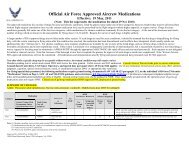

![Body Composition and Military [PDF] - Human Performance ...](https://img.yumpu.com/43269347/1/190x245/body-composition-and-military-pdf-human-performance-.jpg?quality=85)
![Tips for Grocery Shopping [PDF]](https://img.yumpu.com/37447379/1/190x245/tips-for-grocery-shopping-pdf.jpg?quality=85)
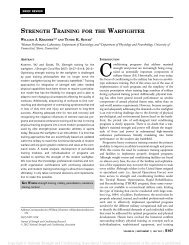
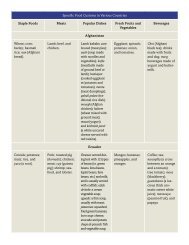
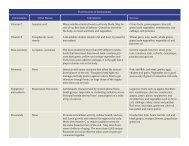
![Synthetic Drugs [PDF] - Human Performance Resource Center](https://img.yumpu.com/37447322/1/190x245/synthetic-drugs-pdf-human-performance-resource-center.jpg?quality=85)
